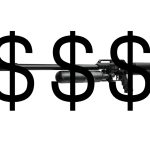The question “Why are airguns so expensive?” comes up often in our industry. Here in the US, we are used to firearms like the Ruger 10/22 with a starting cost of about where we see entry-level PCP airguns. Given the power, flexibility, accuracy, and fun factor brought to the table by the Ruger 10/22, we conceded that it’s a valid question. But airguns also have a lot to offer, and there’s more going under the hood than with a traditional firearm.
Airguns and Firearms are NOT Created Equal
A firearm’s basic mechanics are much simpler to engineer and manufacture than an airgun. Because a firearm relies on the cartridge to provide the power, all you need is the means to point that in the correct direction and ignite the charge. It’s been done for hundreds of years with great success. It’s a simple process that is easily repeatable, and once you have a design that works, it’s up to manufacturing to work out how to repeat the process in mass.
The bottom line is that airguns, specifically PCP airguns, have more parts and operate at much higher tolerances. Additionally, the economy of scale is just not there (yet). The more parts you can run at one time, the cheaper it is for the manufacturer. When Ruger can run hundreds of thousands of parts for a firearm vs. thousands of parts for an airgun (and that would be for a major brand), they will have a better economy of scale. But beyond the raw numbers economics, let’s talk about some of the mechanical differences that make airguns unique and yes, more expensive.
Basic Airgun Mechanics
The big advantage firearms have over airguns is the cartridge. Each round contains the propellant, firing mechanism, and the projectile. These are manufactured by the millions with minimal variances. Sure, there are some brands that are better than others, but when we load our .22 cal magazine, cock the bolt on our Ruger 10/22, and pull the trigger, we expect things to happen reliably every time.
Unlike cartridge-based firearms, PCP airguns operate from an onboard air source. Air is channeled from that source through a valve into a breech, which sends the pellet down the barrel. Where a firearm cartridge has a measured charge for each round, an airgun may or may not have the same function. The pressure in the cylinder will change with each shot, and unregulated airguns can have a large extreme spread due to the changing pressure. Manufacturers either have to work out the perfect balance between the pressure, valve timing, hammer throw, and hammer spring tension or choose to use another piece of gear called a regulator.
Advanced Airgun Mechanics
Given the drive for power, range, accuracy, and consistency, it’s no wonder most airgun makers choose to install regulators into their airguns. A regulator operates like a gateway between the high-pressure, high-volume air source and the valve. The regulator regulates the pressure from the air source and fills a smaller chamber called the plenum. This combo of measured pressure and volume acts like a firearm cartridge. If there’s enough pressure and volume in the main air source, you should get consistent shots from the regulator, delivering the kind of performance most airgunners expect.
Not all regulators are created equal, and some perform better than others. Certain manufacturers like FX even double up, using two regulators and an oversized plenum like on the FX Impact MK III .35 cal, to try and push the limits of power and accuracy. Having spent some time with that platform, we can give it two big thumbs up.
Back to the Cost of Airguns
Given the complexity of airguns, it’s easy to see why they cost more to manufacture. There are simply more moving parts. But what do those moving parts deliver? For many airgunners, having a quiet, backyard-friendly way to get in as much trigger time as practical is worth the investment. For hunters looking to step away from traditional firearms and try something new, they bring a whole new experience level and challenge.
The good news is, like with firearms, you don’t have to spend a ton to get started. There are some great entry-level airguns. And if you really like the sport, there are many options that deliver better accuracy, more power, a nicer shooting experience, etc. And if you have questions about where to start, just give us a call. We’ll be pleased to help ensure your airgun journey starts on the right foot.
